Hadrian's Wall
Hadrian's Wall (ancient Latin name possibly vallum Aelium) was a Roman frontier fortification system of the Britannic Limes, laid out between Newcastle and Solway Firth, near the present-day border between Scotland and England in Britain. It was built between AD 122 and 128 on the orders of Emperor Hadrian (76-138), after he had visited the northern frontiers as part of his inspection tour of all the provinces of the empire. The rampart extended over a length of about 117.5 kilometres. According to the prevailing view today, it did not serve to defend against invasions (the Roman limites were generally not suitable for this purpose), but was primarily intended to monitor trade and passenger traffic and to channel it at the border crossings provided for this purpose, in order to enable the levying of customs duties there, among other things. Furthermore, he was to prevent minor raids as well as the uncontrolled migration of Scottish and Irish tribes into the territory of the province of Britannia inferior.
In its eastern part, the complex consisted of a stone wall up to 4.5 metres high, in the western part initially only of an earth wall. A system of ditches as well as 320 towers, 16 auxiliary forts and 80 milestones were erected for its protection. An almost identical - albeit simpler - system of defence, presumably consisting of up to 26 small forts with attached watchtowers and signal towers, was built on the west coast of what is now the county of Cumbria to protect the flank of the rampart zone.
The remains of the wall still give an idea of how Rome's border fortifications once shaped the landscape. It was the result of a new foreign policy of consolidation and increasing isolation of the empire, which took its final shape under Hadrian. The rampart was the northernmost frontier zone of the Roman Empire until the reign of Antoninus Pius, at whose instigation a new timber-earth rampart system ("Antoninus' Wall") was built on the threshold of the Scottish Highlands. However, this extension could not be sustained for long (from about AD 141 to AD 180). Hadrian's Wall and its forts were again used to monitor the border after the Antonine Wall was abandoned, until Rome left Britain to its own devices in the 5th century.
Large parts of the rampart still exist today, especially in the scenically most impressive middle section. Running mostly on plateaus, it offers a good view over the surrounding countryside. The ground monument is today one of the most famous tourist attractions in northern England and was declared a World Heritage Site by UNESCO in 1987. It is also easy to walk along the Hadrian's Wall Path/National Trail, visiting all the relevant archaeological sites.

Section 49: Construction phases of the eastern abutment of the bridge at Willowford.
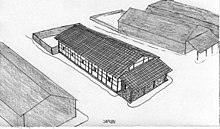
Strip house in the camp suburb of the legion camp Vindobona
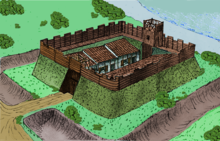
Wooden Earth Fort 21, Swarty Hill, of the Cumbrian Coastal Defence (2nd century condition).
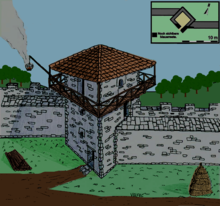
Section 52: Attempted reconstruction of the signal tower at Pike Hill, 2nd century condition.
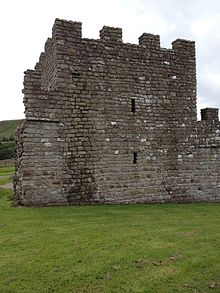
Reconstructed watchtower of the rampart at Fort Vindolanda, view from north
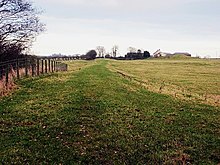
Section 59/60: Hadrian's Wall Path before Bleatarn. The hiking trail there leads directly over the rampart, which is recognizable as a terrain elevation.
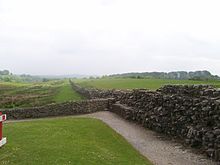
Section 52: The rampart at Fort Birdoswald
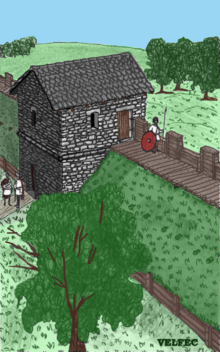
Watchtower 49A secured the early timber-earth rampart
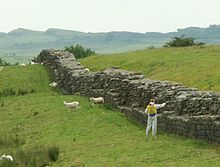
Section 49: Birdoswald; spraying of the wall with weed chemicals

Remains of a kiln in the Meilenkastell 48

Section 48: The remains of Meilenkastell 48, view from the north
_Roman_Fort_-_tower_at_northwest_corner_(2)_-_geograph.org.uk_-_1374211.jpg)
Section 46: Remains of the NW corner tower at Fort Magnis
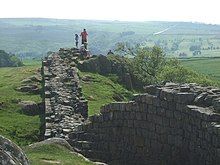
Section 45: Hadrian's Wall at Walltown, on the picture the quarry stone core and the outer casings can be seen very well.

Section 43: Attempted reconstruction of the western gate of Aesica, state in the 4th century AD, view from NW
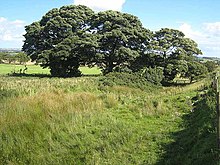
The south moat near the Portgate passageway
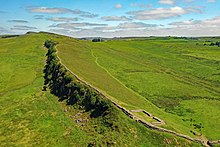
Meilenkastell 42 and course to the east
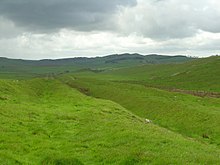
Section 42: The southern ditch near mile fort 42 Cawfields Drag, view from the west.
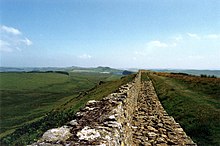
Section 39: South of tower site 39B (Windshields Crag) the original width of the wall can be seen

Section 38: Sycamore Gap valley cut west of mile fort 38

Design features of the wall
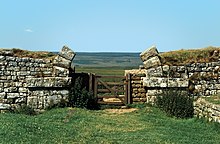
Section 37: Milestone fort 37, view to the north gate
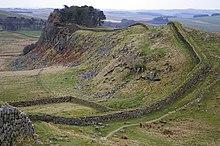
Section 36/37: The rampart west of Housesteads
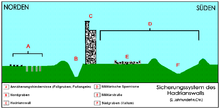
Section through the barriers of Hadrian's Wall

Section 36: Attempted reconstruction of the late antique rampart gate at the Knag Burn
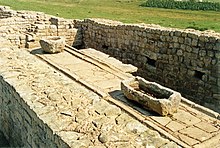
Section 36: Crew toilet at the south-east corner tower of Housesteads
.jpg)
Section 36: Granary in fort Housesteads

Diorama of the fort of Housesteads, condition in the 2nd century AD.
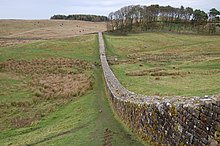
Section 36: Part of the rampart section restored by John Clayton (1792-1890) at Fort Housesteads.
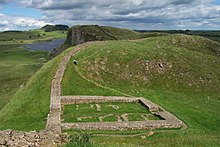
Section 34: The ruins of the Meilenkastell 34 (Castle Nick) in the middle section of the rampart
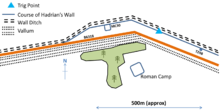
Section 30: course of the northern ditch and fortifications at Limestone Corner section

Section 30: Unfinished trench section at Limestone Corner
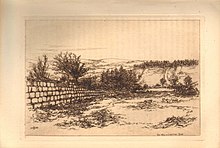
Section 30: Drawing of the rampart at Teppermoor Hill (1885)
_-_geograph.org.uk_-_809577.jpg)
Section 27: Remains of the eastern abutment of the Wall Bridge at Chesters
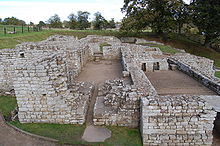
Section 27: Chesters camp thermal spring
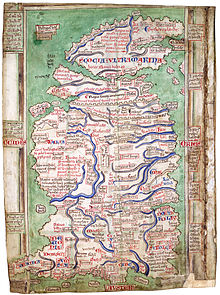
Map of Britain by Matthew Paris (c. 1250), showing Hadrian's Wall as well as Antoninus Wall, British Library, London

Section 7: Remains of the rampart at Denton Hall

Section 6: Reconstruction attempt of the Vallum Gate at Benwell
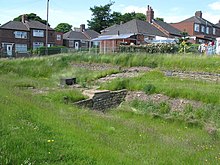
Section 6: The remains of the ditch crossing at the rampart fort Benwell
.jpg)
Section 0: Reconstruction of the wall in Wallsend, view from SE
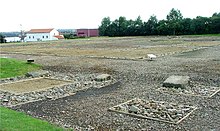
Section 0: Excavations at Fort Segedunum (Wallsend)
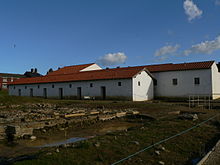
Reconstructed barracks and commandant's house in South Shields
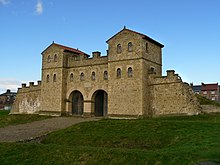
Reconstruction of the west gate of Fort Arbeia (South Shields)
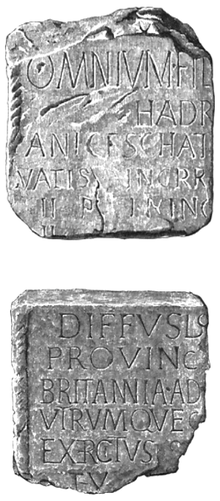
Consecration inscription from Jarrow
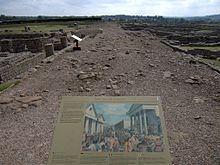
The ruins of the fortified city of Coriosopitum at the junction of the Stanegate and the Dere road; this city was an important supply base for Hadrian's and Antoninus' Wall
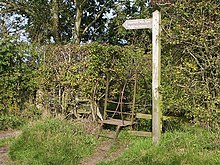
Signpost on Hadrian's Wall Path at Burgh by Sands
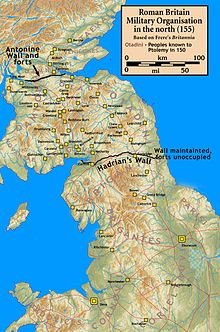
Wall fortifications and forts in northern Britain (155 AD). At this time, the forts on Hadrian's Wall were largely unmanned.

Relief from Netherby (Castra Exploratorum), probably depicting the genius of the wall
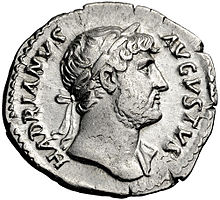
Coin portrait of Hadrian
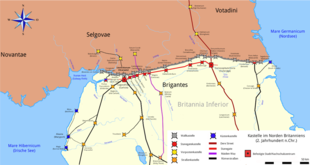
Location sketch of the Stanegatestraße and Hadrian's Wall with locations of their forts
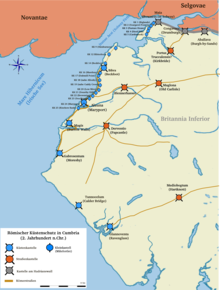
Forts on the Cumbrian Coast
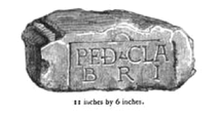
Centurial stone of the Classis Britannica, found near Birdoswald
Location and topography
The Wall Zone was located on the territory of the Roman province of Britannia inferior, after the division in late antiquity on the territory of the province of Maxima Caesariensis, which included the whole of northern Britain.
As far as Wallsend, the Tyne estuary formed a natural boundary to the east coast. The wall extended for 117.5 kilometres (78 Roman miles), starting in the east at Segedunum, from the north bank of the Tyne eight kilometres overland to the fort of Pons Aelius (now Newcastle upon Tyne), Condercum (now Benwell), Coriosopidum (now Corbridge), Luguvalium (now Carlisle), to name but a few, to the westernmost fort of Maia (now Bowness-on-Solway), where it ended at the Solway Firth. This is a fjord which opens out to the Irish Sea after 30 km. After Bowness-on-Solway the fortifications continued along the west coast of Cumbria, reinforced by a series of small forts and towers - south to Maryport. All these sites lie to the north of a once important Roman military road and boundary marker, known as Stanegate between Carlisle and Corbridge, which there intersected with Dere Street leading to Scotland. The rampart closes the isthmus between the mouth of the Tyne and the Solway Firth, and connects across the central hill country of the Pennines, the mountains in the west of the island with the eastern heights. The Wall terrain averages 150 metres above sea level, reaching its highest elevation (680 metres) at the Whin Sill's. This area has been intensively farmed since before the Romans arrived. The isthmus was ideal for the construction of a barrier, partly because this region of Britain lacks natural boundary markers - such as rivers.
History
The route on the northern side of the river valleys of Tyne, Irthing and Eden was already known to the Romans since the campaigns of Agricola in the 1st century. The Stanegate military road, secured by forts and watchtowers, also ran along the valley floor there, marking the northern border in Britain from AD 105. Unlike the Stanegate road, which essentially followed the valleys, Hadrian's Wall ran as far as possible along the ridges of the hills. From the east the rampart stretched from Wallsend to Chesters and from there began to ascend via its northernmost point, Limestone Corner, to the impressive basalt cliffs of the Whin Sills, from where there are good views of the surrounding countryside. These, a 20-metre-high lagoon of volcanic rock, then drop steeply to what are known as the Craigs. At Willowford the rampart crosses the Irthing and now keeps closely to its north bank. West of Carlisle the Wall finally reaches the marshes of the Solway, where it runs between Burgh-by-Sands and Bowness-on-Solway on a line just above the high-water mark. From Bowness onwards the boundary defences continued along the Cumbrian coast.
Questions and Answers
Q: What is Hadrian's Wall?
A: Hadrian's Wall is a stone and turf fortification built across northern Great Britain by the Roman Empire in the early second century. It was built to control barbarians, specifically the ancient Britons to the north of the wall.
Q: How long was Hadrian's Wall?
A: The wall was about 118 kilometres (73 miles) long. Most of the wall – 67 kilometres (42 miles) – was made of stone, and for 46 kilometres (29 miles) it was made of turf.
Q: How thick and tall were parts of Hadrian's Wall?
A: The stone part of the wall was 3 metres (9.8 feet) thick and about 4.2 metres (14 feet) tall, while the turf part was 6 metres (20 feet) thick and also about 4.2 metres (14 feet) tall.
Q: Where did Hadrian's Wall start and end?
A: The east end of Hadrian's Wall originally started at Newcastle upon Tyne, but later on more stone wall was added for an additional 6 kilometres (3.7 miles), ending at Wallsend on Tyne.
Q: What other features were associated with Hadrian's Wall?
A: In front of the wall there was a ditch that ran parallel to it which measured 3 metres deep and 8.2 metres wide, as well as small watch towers/fortes along its length known as Vallum which ran from coast to coast south of the wall itself.
Q: When did Romans use this structure?
A: The Romans used this structure for at least two hundred years until their departure from Britain in 410 AD when they abandoned all their fortifications in Britain including Hadrian’s Wall .
Q: When did UNESCO list it as a World Heritage Site?
A:Hadrian’s Wall became a UNESCO World Heritage Site in 1987 where it shares its listing with Antonine Walls in Scotland and German fortifications known as Limes Germanicus
Search within the encyclopedia